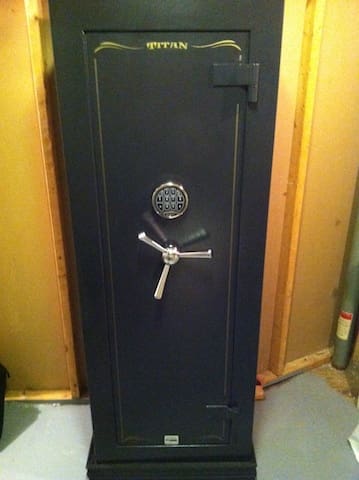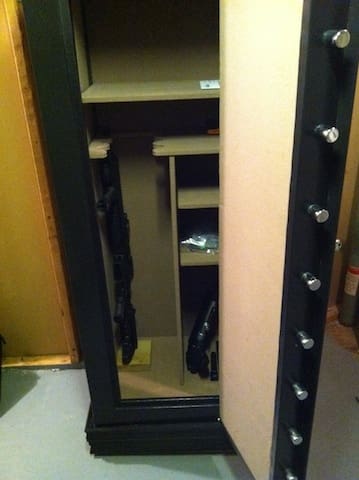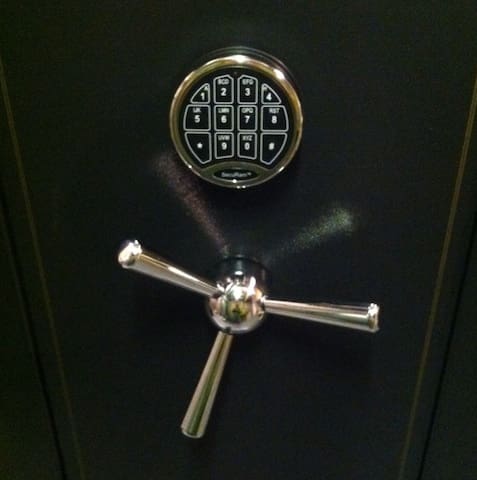You don’t need me to tell you that a good gunsafe is a necessity. My biggest problem: moving large items around my New York condo is about as easy as to me as taking Thermodynamics II at MIT. It can’t be done by me or anyone I know. The SnapSafe, safe that can be moved in sections to any room, holds [almost] all the appeal of Bar Rafieli in spandex. The Zanetti has been around for years; the ads in the American Rifleman piqued my interest in SnapSafe. The lack of online reviews made me leery. t certainly solved my logistical problems. So I gambled a Grover, got a little change back, and found out . . .
For a shopping comparo, my local safe shop their own in-house brand that was probably a relabeled AmSec (American Security), but I can’t be sure. I know I took 10 minutes playing with it, checking out the mechanism, and unscientifically banging on the walls to get an idea of what a $1500 safe should deliver.
The SnapSafe Titan touts fire protection of 2300 degrees for one hour (I can’t test that unless Nationwide wants a pissed-off adjuster). But you do get to install the fire retardant padding/blankets yourself and it looks of high quality.
The big issue: weight. The AmSec unit that caught my eye weighed just over 600 pounds. The SnapSafe clocked in at a Biggest Loser-like 310 pounds. But then again, the biggie would be destined for a basement. The SnapSafe was headed for an upstairs closet.
I was growing more leery, but you have to make these units so they can be shipped and moved by non-MMA heavyweights and not test the load construction of my joists. 310 seemed reasonable enough to stop but all of the most determined thieves looking to play North American Van Lines, especially when you consider the hurdles they come across in my particular installation (and hopefully a screaming alarm).
The SnapSafe Titan comes very well packed on a plywood skid all wrapped up nice in cardboard and Styrofoam. The heavy outer walls are divided into seven pieces, and the interior panels and shelving are another 10 pieces.
The company is cool enough and smart enough to send you a PDF file of the instruction manual before it arrives so you can read up in advance. Moreover, when the Titan arrives with every panel clearly labeled. The rest of manual comes in a quality binder. The finish of the powdercoat looks nice, and the chrome door handle spoke knobs would not look out of place on a sailing yacht.
While anyone with a little lifting ability and mechanical knowledge should not have a problem assembling and installing the SnapSafe Titan, a second person is highly recommended. The door, as with most safes, is the heavy part. This one weighs around 90 pounds. There are eight chrome-plated locking bolts. All the other pieces can be transported by one person.
Getting the door aligned to the hinges needs the guiding of a helper. After that, it’s plug-and-play. I should have done a photo montage of everything going together, but my helper had limited time and the room we assembled it in had limited lighting. Sorry guys.
On the SnapSafe website, they show the unit going together with buckles like you would find on a 70s era Samsonite luggage piece sans jumping gorilla. Now, the company has switched to steel washers with wingnuts welded on them as the hardware. This facilitates the install because it allows you to really snug up on the fasteners located in awkward positions. I laid out all of the pieces and got to work.
First you build the outer shell, then install the fire-retardant blankets, then install the interior panels that are covered in taupe mouse fur / high-end felt. The only snag: installing the interior finished back wall of the safe.
From the looks of it, there should be no way in human hell it can be squeezed in there after the outer shell is assembled. I actually bothered to call customer service before I potentially bent the back wall and had to live with looking at it mutilated for the next 30 years. They were great . . . you just keep playing with it using different approach angles. It go in (dammit).
Once the Titan’s door’s in place, you can then install the finishing panels. It took me and my helper about an hour-and-a-half from start to finish. Like our Fearless Leader, I suffer from OCD. So I double-checked that every fastener was tightened to maximum torque without stripping the studs.
You can rush it to 45 minutes—but rushed installs (especially over-torqued fasteners) will bite you in the ass years down the road when you get to dissemble it and move it yourself to your new digs. Which reminds me: in that situation, the SnapSafe Titan will more than pay for itself. Get some quotes from a safe moving company if you don’t believe me. It’s only cheap to move into your house when you first purchase it.
The guts running the Titan: a SecuRAM Electronic Combination Controller. You get to pick a six-digit code. A 9V battery powers the works. SnapSafe’s SecuRAM controllers are made in China; they lack the pedigree of Sargent & Greenleaf. After a little online research, I was Ok with the cost-saving. Personally, so far so good. And I like simplicity- just punch in your six digit code and wait for the beep. Give the spokes a twist and you’re in.
You can alter the SnapSafe Titan’s shelves’ height to your liking. Or forgo the shelves for a long gun only option that will store about a dozen rifles—depending on optics and your packaging ability.
I completed my install by fabricating a raised pedestal with extra ballast that the SnapSafe sits on in case there is ever a leak in the plumbing (it has happened before). Normal people can just drill it right into the basement cement using masonry bits and hardware. I added an extra overhead light to illuminate the interior, just in case I needed to pick the right gun in a hurry.
The SnapSafe Titan is a well-designed product with engineering smarts in a world of dumb boxes. The company was a pleasure to deal with. You can store your firearms properly, even in a five-story tenement walk-up, without breaking the bank. It does not offer the same security like a top-of-the-line Liberty or Fort Knox. But just as few people walk about with full-size carry guns, sometimes something smaller, less expensive, and more modular fits the bill.
SPECIFICATIONS
Dimensions: 59″H x 22″W x 20 1/2″ D
Price: $799 + $100 shipping
RATINGS (out of five stars)
Style * ***
Nicely executed for the price point. Tasteful gold lettering, thick chrome spokes, and nice powdercoat.
Ergonomics * * **
Program your six-digit code, wait for the beep, and you are ready to roll.
Reliability * * * *
So far it opens every time.
Customize This * * * **
You can set the height of the shelves or forgo shelves altogether- whatever works for you
OVERALL RATING * * * *
For the size, weight, price, and overall experience, this is a winner.







Neat idea, I really like the idea of being able to move a safe around in pieces and reassemble it wherever I want it. The big drawback to me about this safe is the lock itself: we’ve been looking at safes, and the digital ones are housed in little plastic cases with wires running inside to the lock works. What happens if there’s a fire? That plastic is going to melt and burn. Then you have to have a locksmith out to drill your safe to get it open. Personally, I want a regular dial with tumblers and all that, so if my apartment burns down, I can go to the safe, spin the dial, and get my goods out.
That’s just me, though.
You are right Rebecca, I am sure the SecuRAM lock mechanism will turn into plastic sauce in a fire. However, after living with S&G tumblers my whole life, there is something to be said for shedding a minute off of the access time. I don’t think I can go back to analog even after a few days of digital.
Looks like a decent solution for someone who has to store firearms in a 2nd-floor space without an elevator. I have used one of the locking-steel rifle-storage boxes that bolt to wall studs and are not fireproof, on the basis that any security is better than hiding them under your bed or in the back of your closet. Bought a Liberty fire-resistant safe a couple of years ago, and have been happy with it. Old-style S&G mechanical combination lock. My personal defense handgun is stored in a V-Line “in the wall between the studs” handgun safe, with a push button lock (5 buttons that you can set up any way you like). Not as secure as a real safe, but convenient in my bedroom closet, doesn’t protrude into the closet space, and was $200. It will keep the average teenage burglar out, unless he takes the time to disassemble the interior closet wall. Again, any security for your collection is better than stacking them in your walk-in closet. If you consider that a decent safe will cost you about as much as ONE of your high-end handguns, the price doesn’t seem so bad any more.
Will it hold a child? That would be one way to keep my guns safe.
Be sure to bolt the safe to the floor or wall. Allow me to explain. Electronic safes use solonids to prevent the gears from turning and pulling back the bolts. If the solonid normally points up (held in place by the solonid spring) and is pulled down by electric flow then pushing the safe back and letting it fall forward can bounce the solonid (sans combination) and the safe door will open. If the solonid is sideways, opening is harder; pointing down/really, really harder.
Yes, I’m a locksmith/safe technician (retired).
I like the idea of assembly for a safe, but I would prefer a mechanical lock.
JJ Swiontek,
The idea that letting a safe bounce on the floor will open one of our locks would never pass UL Testing which our locks have. The technique your referring to I assume is the one that works on $20.00 safe locks. Not professional grade locks like a SecuRam EL-0601A
If you have any questions regarding our controller or lock please let us know.
where is snapsafe made? that is the question
I really like the idea behind this safe, as I’ve been looking for something light enough to place in an upstairs closet. Does the safe have any sort of deadbolt on the hinged side of the door? And how easy would it be to pry the Kwik-Lock joined sections? It’s hard to tell from their website, but the Kwik-Lock looks like it might just be two plates of steel joined by a bolt and wing nut. Thanks for the good review.
I bought an XL some time ago. The main reason I chose this brand was it being a modular safe, it was going in an upstairs bedroom. There are Pros and Cons to this. Communication was great, couldn’t ask for better customer service. When it arrived it was brought right to my garage door. Unpacking was straight forward and very well done. Every panel was easy to take upstairs by myself except for the front and rear panels, along with the door. Assembly is a simple process but I had troubles with the fireproof blankets staying in place. Maybe I did something wrong but they were a real BEAR! They never did completely cover the inside walls. My fear is that with the blankets leaving gaps it seems the “fire proofing” has been compromised? The panels fit very tight and can be a bit of a pain getting them into place, but once they are in, it looks great. Door drops into place easily as well. The lock seems to be fine and was very easy to program. I have troubles keeping the heat gaskets around the door in place. They won’t stay stuck. Every time I open the safe, the strips fall loose or off completely. I’ll have to glue these on some how. Also, when the assembly labels were removed, they left a very nasty residue behind. I tried GooGone and Goof Off, but neither worked. I tried Denatured alcohol, a mild cleaner/de-greaser, it started to remove the black paint. So my guess is that these safes arent a baked on or enamel finish.
All and all its a good safe and protects my weapons from theft should I be robbed, which was the main reason I purchased a safe. But I’m concerned about how well it would do in a fire. Thats something I hope I’ll never find out.
Bottom line, would I buy this again or recommend it to a friend……. probably not, and honestly, I wish that wasn’t my answer. I really want to recommend this safe but the most I’d say is it’s “O.K.”.
These safes can be ordered with higher grade steel (7 gauge) for an additional $100, as well as a mechanical dial lock. Check their website for details.
Where are the components of the safe made? What country?
I didn’t notice the safe having a hard plate over the lock and relocker. This is to protect against drilling. Is there an option to have one installed?
TRY A PRODUCT CALLED “BESTINE ” TO REMOVE STICKER GLUE. AVAILABLE AT ART SUPPLY AND CRAFT STORES. CONTAINS A RUBBER SOLVENT (N-HEPTANE) .
NOTE: I AM INFORMED BY THEIR CUSTOMER SERVICES THAT SNAP SAFE IS WORKING ON DOUBLE DOOR VERSION OF THE SUPER TITAN XL AND WILL BE PHASING OUT THE SINGLE DOOR MODEL. DUE SOMETIME THIS FALL. 2017.
Where are these safes manufactured (not assembled)?
CHINA. They are made in China. Nowadays they are all made with two layers of 14 guage steel which they call 9 gauge. I doubt it is as strong as 9 gauge.
I have no faith in their fire rating either but at least they give you some fire lining unlike Zanotti safes. The Zanotti doesn’t even give you an expanding door seal. As you know, acids from the smoke destroy firearms.
I do like the tall sizes of the Zanotti and the fact that they are USA made, I don’t like it that shipping is not included like with Snapsafe. Zanotti is 11 gauge now, I believe they used to be thicker. Like everything, price goes up and qualify goes down.
Neither fire rating uses UL standard so they can say anything. Definitely the 20 minutes Zanotti claims is useless.
The SnapSafe had me until I saw it has a “Lock override key”. That is a SERIOUS security weakness. Not only is there no real deterrent against drilling but they PREDRILLED THE HOLE FOR THE THIEF!
If you are buying a safe the size mentioned, just get a real one (with external hinges) and lift the door off. That turns a 300 pound safe into a 200 pound safe and a 100 pound door. I took one of these up two flights of stairs with only one skinny helper.
The SnapSafe mentioned is $2,000 now. A comparable safe (Technically they are called RSC residential security container as they do not meet the criteria of a safe) is $500.
If you need a larger RSC then rent a “Stair Climber” dolly for a hundred bucks. I have seen one man move a 1000 pound safe up a flight of stairs single handed with one of those. Look it up on YouTube.
Comments are closed.